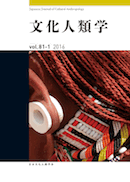Volume 72, Issue 2
Displaying 1-29 of 29 articles from this issue
- |<
- <
- 1
- >
- >|
-
Article type: Cover
2007 Volume 72 Issue 2 Pages Cover1-
Published: September 30, 2007
Released on J-STAGE: August 22, 2017
Download PDF (192K) -
Article type: Cover
2007 Volume 72 Issue 2 Pages Cover2-
Published: September 30, 2007
Released on J-STAGE: August 22, 2017
Download PDF (192K) -
Article type: Appendix
2007 Volume 72 Issue 2 Pages App1-
Published: September 30, 2007
Released on J-STAGE: August 22, 2017
Download PDF (156K) -
Article type: Appendix
2007 Volume 72 Issue 2 Pages i-iii
Published: September 30, 2007
Released on J-STAGE: August 22, 2017
Download PDF (843K) -
Article type: Appendix
2007 Volume 72 Issue 2 Pages iv-
Published: September 30, 2007
Released on J-STAGE: August 22, 2017
Download PDF (165K) -
Article type: Article
2007 Volume 72 Issue 2 Pages 141-164
Published: September 30, 2007
Released on J-STAGE: August 22, 2017
Download PDF (4197K) -
Article type: Article
2007 Volume 72 Issue 2 Pages 165-187
Published: September 30, 2007
Released on J-STAGE: August 22, 2017
Download PDF (4730K) -
Article type: Article
2007 Volume 72 Issue 2 Pages 188-200
Published: September 30, 2007
Released on J-STAGE: August 22, 2017
Download PDF (2478K) -
Article type: Article
2007 Volume 72 Issue 2 Pages 201-220
Published: September 30, 2007
Released on J-STAGE: August 22, 2017
Download PDF (3605K) -
Article type: Article
2007 Volume 72 Issue 2 Pages 221-240
Published: September 30, 2007
Released on J-STAGE: August 22, 2017
Download PDF (3644K) -
Article type: Article
2007 Volume 72 Issue 2 Pages 241-268
Published: September 30, 2007
Released on J-STAGE: August 22, 2017
Download PDF (5095K) -
Article type: Article
2007 Volume 72 Issue 2 Pages 269-273
Published: September 30, 2007
Released on J-STAGE: August 22, 2017
Download PDF (987K) -
Article type: Article
2007 Volume 72 Issue 2 Pages 274-275
Published: September 30, 2007
Released on J-STAGE: August 22, 2017
Download PDF (518K) -
Article type: Article
2007 Volume 72 Issue 2 Pages 275-278
Published: September 30, 2007
Released on J-STAGE: August 22, 2017
Download PDF (912K) -
Article type: Article
2007 Volume 72 Issue 2 Pages 278-281
Published: September 30, 2007
Released on J-STAGE: August 22, 2017
Download PDF (880K) -
Article type: Article
2007 Volume 72 Issue 2 Pages 281-285
Published: September 30, 2007
Released on J-STAGE: August 22, 2017
Download PDF (1018K) -
Article type: Appendix
2007 Volume 72 Issue 2 Pages 286-
Published: September 30, 2007
Released on J-STAGE: August 22, 2017
Download PDF (325K) -
Article type: Appendix
2007 Volume 72 Issue 2 Pages 287-
Published: September 30, 2007
Released on J-STAGE: August 22, 2017
Download PDF (145K) -
Article type: Appendix
2007 Volume 72 Issue 2 Pages 288-
Published: September 30, 2007
Released on J-STAGE: August 22, 2017
Download PDF (121K) -
Article type: Appendix
2007 Volume 72 Issue 2 Pages 289-292
Published: September 30, 2007
Released on J-STAGE: August 22, 2017
Download PDF (496K) -
Article type: Appendix
2007 Volume 72 Issue 2 Pages 292-
Published: September 30, 2007
Released on J-STAGE: August 22, 2017
Download PDF (78K) -
Article type: Appendix
2007 Volume 72 Issue 2 Pages 293-298
Published: September 30, 2007
Released on J-STAGE: August 22, 2017
Download PDF (1176K) -
Article type: Appendix
2007 Volume 72 Issue 2 Pages 299-301
Published: September 30, 2007
Released on J-STAGE: August 22, 2017
Download PDF (462K) -
Article type: Appendix
2007 Volume 72 Issue 2 Pages 301-
Published: September 30, 2007
Released on J-STAGE: August 22, 2017
Download PDF (126K) -
Article type: Appendix
2007 Volume 72 Issue 2 Pages 302-
Published: September 30, 2007
Released on J-STAGE: August 22, 2017
Download PDF (157K) -
Article type: Appendix
2007 Volume 72 Issue 2 Pages App2-
Published: September 30, 2007
Released on J-STAGE: August 22, 2017
Download PDF (83K) -
Article type: Appendix
2007 Volume 72 Issue 2 Pages App3-
Published: September 30, 2007
Released on J-STAGE: August 22, 2017
Download PDF (83K) -
Article type: Cover
2007 Volume 72 Issue 2 Pages Cover3-
Published: September 30, 2007
Released on J-STAGE: August 22, 2017
Download PDF (139K) -
Article type: Cover
2007 Volume 72 Issue 2 Pages Cover4-
Published: September 30, 2007
Released on J-STAGE: August 22, 2017
Download PDF (139K)
- |<
- <
- 1
- >
- >|
